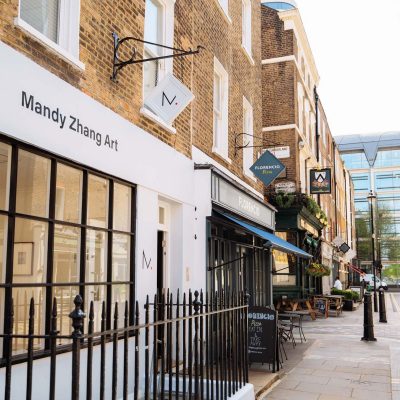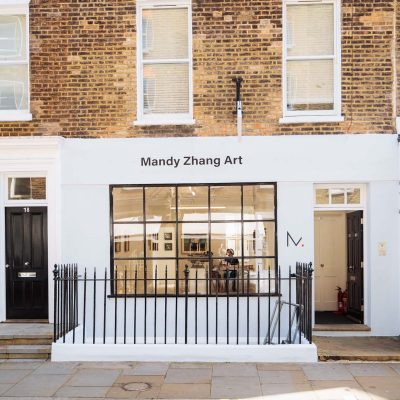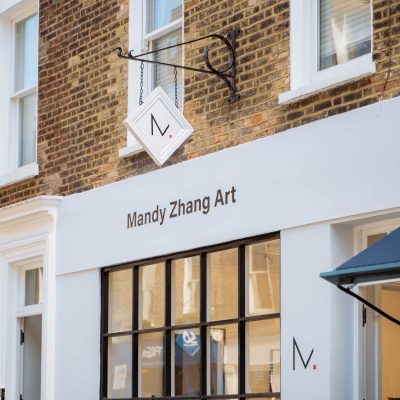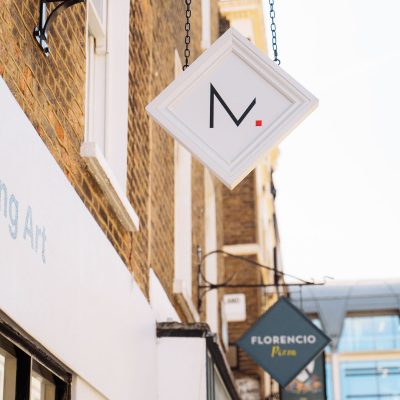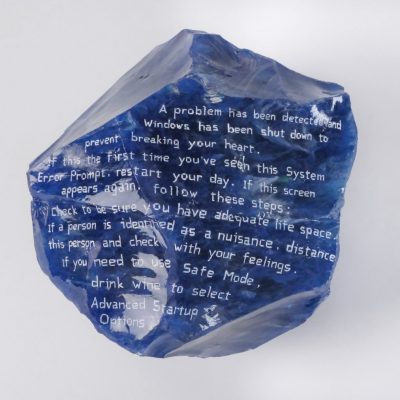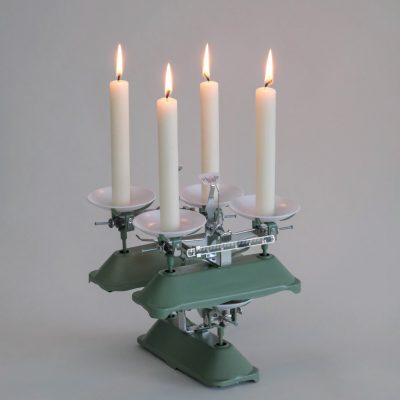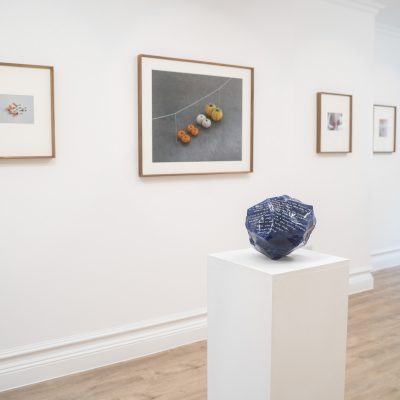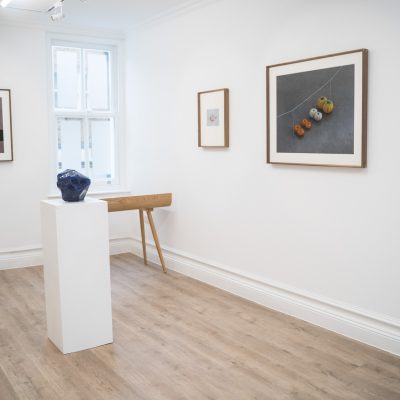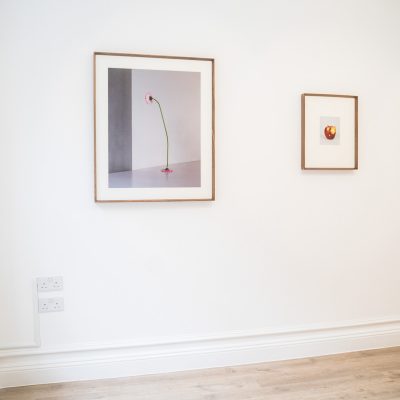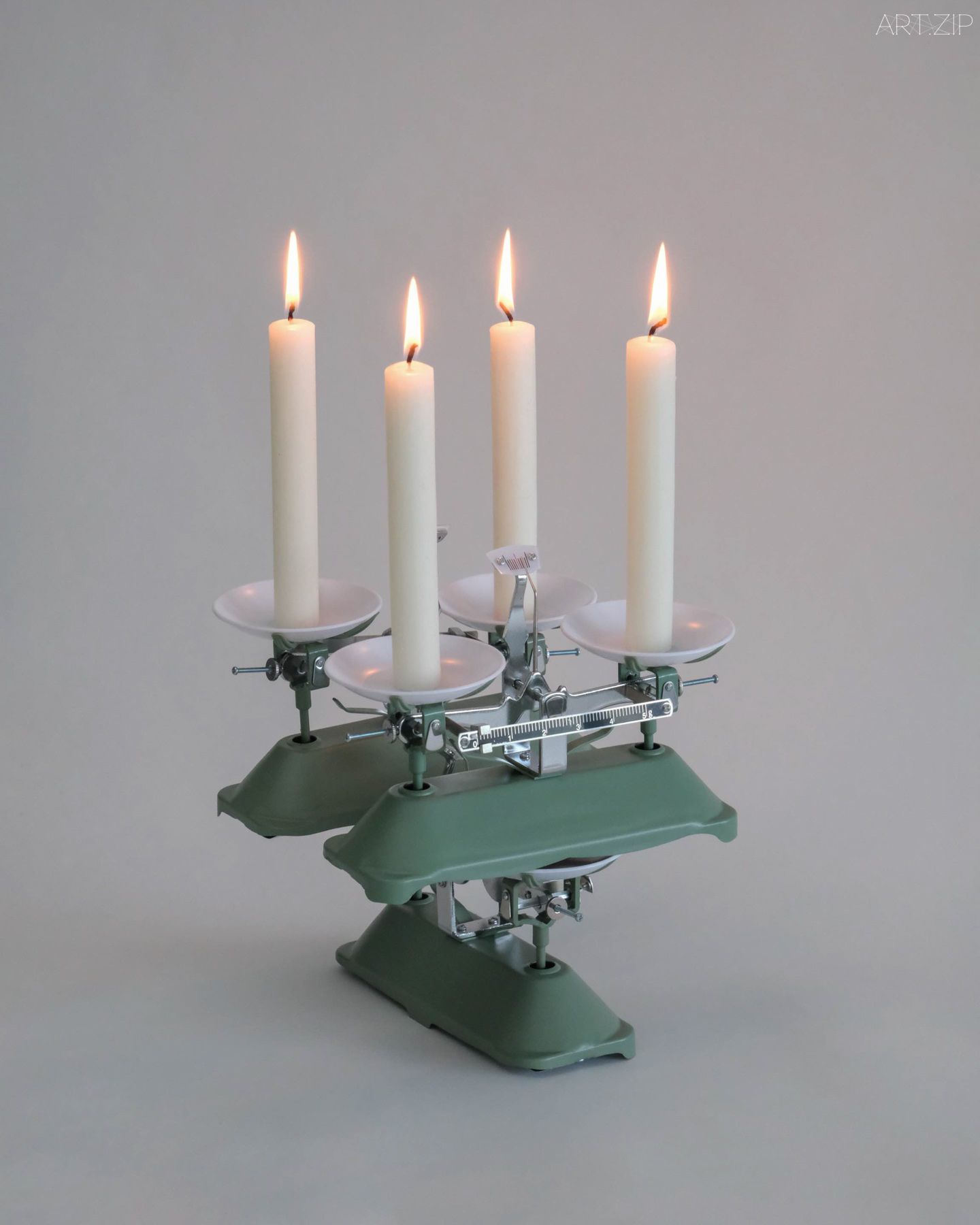
This April, the Chinese-born curator and gallery director Mandy Zhang takes her art gallery into a new expansion by opening a permanent exhibition space in Marylebone. The inaugural exhibition titled Bruises marks the UK solo debut of emerging artist Can Sun, from 12 April to 24 May 2024.
The exhibition features a range of Sun’s new and recent series of still-life photography, sculpture, and video work, making a remarkable debut for both the recent Royal College of Art graduate and the establishment of the new gallery space. His work explores humour in the reality of absurdity and the relationship between people and objects by challenging traditional notions of sculpture and photography.
Since the end of 2022, Mandy has spearheaded a series of curatorial practices, special events and projects in the international art market that support young emerging Asian artists. The new chapter of Mandy Zhang Art will retain its focus on showcasing young and ambitious artists from Asia and its diaspora and supporting them to launch their careers in the contemporary art community. The establishment of this new space also highlights Mandy Zhang Art’s commitment to broadening and diversifying its audiences beyond the professional circles, transitioning from her private apartment to the street-front public gallery.
Interview with Mandy Zhang
AZ: Congratulations. What does this moment mean to Mandy Zhang Art?
MZH: Thank you! The opening of our new space at 16 Seymour Place in Marylebone is a significant milestone. This expansion reflects our growth and resilience as a young gallery, as well as our commitment to advancing the discourse around Asian contemporary art in London. It’s a reaffirmation of our mission to provide a platform for emerging Asian artists. More importantly, it allows us to showcase more diverse programmes to a broader audience for deeper engagements.
AZ: Could you walk us through the process of having your own space and curating the debut exhibition at the new Mandy Zhang Art? What were the key challenges and triumphs?
MZH: Opening a new space was both challenging and exhilarating. From securing the lease and setting up the space to the launch of the debut exhibition, it took me over half a year. One of the main challenges was to transform a small space into one that is both welcoming and versatile for a wide range of exhibitions and interactive experiences. The process of curating the first show involved meticulous planning, from ideation to execution, ensuring that every piece displayed resonated with the theme and together formed a coherent narrative. Triumphs include the successful launch of the exhibition. It has been well-received by our existing collectors, supporters, and new audiences.
AZ: Could you describe the apartment shows you held before opening your physical gallery? What aspects of those shows were most impactful, and what motivated you to transition to a permanent gallery space?
MZH:The apartment shows were interesting because we needed to utilise every available space—hallways, the kitchen, even a closet door—to display art. Curating in such a non-traditional space post unique challenges but is incredibly rewarding. Visitors frequently expressed their appreciation for the intimacy and uniqueness of viewing art in a home environment. They felt it altered the dynamics of the artworks significantly. While I cherished the personal interactions these settings facilitated, practical considerations drove the move to a permanent gallery space. A shop-front space not only increases exposure for the artists and their works but also addresses logistical issues such as neighbourhood noise concerns during openings.
AZ: You studied philosophy before venturing into contemporary curation. How has that education influenced your current curatorial practices?
MZH: Philosophy has profoundly shaped my approach to curation, primarily through the critical thinking skills it fostered. I could go on and on about how philosophy and contemporary art and curation relates to each other and how contemporary art was started by philosophy thinking. For me, it was never about applying specific philosophical theories to the exhibitions. My education has enabled me to perceive the world—and the art within it—in a more rounded way. It’s about understanding the layers beneath the surface, much like deciphering the deeper meanings behind what the artist is presenting through their work.
AZ: What are your opinions on the current state of representation of Asian contemporary artists?
MZH: It is undeniable that there has been increasing attention paid to Asian contemporary artists in recent years. I am excited to see that more and more prominent arts and cultural institutions are exhibiting works from Asian artists. However, compared with artists from other regions and continents, there is still a long way to go for Asian artists in terms of visibility and representation. While there are increasing opportunities for exposure, many talented Asian artists remain underrepresented due to barriers posed by differences in language, culture, and ways of working, particularly in Western art markets. My goal is to reduce these barriers by providing a dedicated platform that not only showcases their work but also contextualises it in a way that resonates globally, thus elevating their presence in the broader art world.
AZ: What is the conceptual framework that underpins your curatorial approach at Mandy Zhang Art, given your dedication to supporting young emerging Asian artists, the only gallery in London with this specialism?
MZH: The centre of our curatorial approach at Mandy Zhang Art is cross-cultural narratives. The benefit of a cross-cultural framework is that it enables alternative storytelling and brings together different cultural backgrounds, unlocking new possibilities to think about the past and the future. Through actively promoting emerging Asian artists, we are committed to enriching the contemporary art scene and strengthening the Asian contemporary art communities by bringing forward fresh perspectives and voices. The cross-cultural framework also plays an important role in the process of decolonising art history, which has been long dominated by a traditional Eurocentric view.
Each exhibition we curate is a journey for viewers to discover or rethink established narratives and notions of culture and identity. We want to showcase works that highlight the similar yet unique experiences among Asia diaspora in different contexts to dismantle cultural hierarchies, contributing to a more diverse conversation in the contemporary art world about cultural equity.
AZ: How do you compare Mandy Zhang Art with other similar galleries, and in what ways is it unique?
MZH: Mandy Zhang Art holds a unique position in London’s art scene as one of the few, if not the only, galleries dedicated solely to representing Asian contemporary artists. This focus is not just a niche but a commitment, and while some questioned the viability of focusing on such a specialised market, we will proudly pioneer this space and prove its potential through our work in the future to come.

Can Sun, The God of Icecream (2024) Photograph, Giclee Print on Bainbridge Paper
AZ: How do you describe your curatorial style? How do you integrate cultural stories and artistic expressions to create cohesive themes and narratives?
MZH: My curatorial style is balanced and narrative-driven. On the one hand, I deeply believe that great works speak for themselves when presented in the right way. On the other hand, I strive to weave together cultural histories, personal narratives, and artistic expressions to craft a cohesive story for each exhibition. I aim to deliver exhibitions that are both visually provoking and intellectually enlightening, meanwhile making it playful and easy to understand for visitors to discover at their own pace. For example, in the debut exhibition ‘Bruises’ we incorporated a lot of black humour threaded across the main exhibition text, titles of works, and display labels to echo the essence of the theme, guiding visitors to dive deep into the artist’s spiritual world beneath the visual provocation. In a previous exhibition, ‘I Saw a Sun and a Moon as I Entered the 7th and 8th Rib’ with artists Serena Huang, we visualised acupoints in the format of wordplay games, allowing the audiences to quickly understand concepts in Chinese Medicine, a discipline that is profound and often hard to explain cross-culturally. This process involves selecting works that will resonate with viewers on both individual and collective levels, allowing them to feel invited to explore and connect with the artworks.
AZ: How did you adjust your curatorial approach and exhibition strategies moving from apartment exhibitions to owning a physical gallery space? How do these two types of spaces differ in terms of interaction and presentation?
MZH: Having had the experience of a home gallery has significantly influenced my curatorial approach especially in visitor experience. It made me understand how important it is to make art accessible and the gallery experience welcoming, reminiscent of a home setting. It is a fine balance. In the apartment, we had to ensure the environment is not too personal for visitors, while now in the white-cube style gallery, we go to great lengths to create a warm environment, from the way our staff greets visitors to the hand-picked, thoughtful arrangement of flowers throughout the space including the restroom. I am also exploring collaborations with artists who design furniture, aiming to make the gallery space feel as inviting and comfortable as possible.
AZ: You stressed the importance of having underrepresented voices in the art world. How do you ensure these voices are not only heard but also understood by a broader audience?
MZH: To ensure these voices are understood, we select artworks that are open to interpretations and infused with multiple layers of meanings. This allows our audience to engage at different levels—from enjoying the immediate, sensory pleasures to delving into deeper, more intricate stories and contexts. Furthermore, we enhance audience engagement by hosting a range of programmes and events that extend beyond commercial purposes, such as artist talks, workshops, and performances. These events offer direct insights into the artists’ processes and intentions, helping to bridge any gaps between the artwork and the viewer. By fostering this deeper engagement, we have been able to amplify these important voices, creating a space where they can be fully understood and valued by our audiences.
AZ: How do you go about selecting artists and their works for exhibitions at your gallery?
MZH: We focus on artists with cross-cultural backgrounds who are deeply rooted in Asian cultures but also have navigated living overseas. The dual exposure allows the artists to express their Asian influences in a way that is more relevant to the global audience. Another key criterion for us is ‘contemporaneity’ – we seek artists whose works reflect and engage with contemporary issues and dynamics. Their works should be the reflection or carry deep reflections of the society we live in and provide unique perspectives.
AZ: What ambition do you have for the following shows for 2024? What could we expect?
MZH: We have an exciting line-up of exhibitions planned for the rest of the year at Mandy Zhang Art, featuring exclusively female artists by chance. Up next, Silia Ka Tung reimagines ancient myths and fairy tales, bringing a feminist perspective to traditional narratives. In September, Sophie Zhai’s portrait photography will blend with natural settings, exploring identity and environment. In October, we will showcase Syeda Aatika Fatima’s thought-provoking series on privacy and surveillance. Then we will close with Serena Huang’s deep exploration of Taoism, Chinese Medicine, and natural sciences. Each show promises to bring fresh perspectives to contemporary issues, enhancing cultural discourses with diverse and dynamic voices. We hope that you will come along and join us.
今年四月,出生於中國的策展人兼Mandy Zhang Art的畫廊主理人張潔伊在倫敦馬里波恩開設了一個永久性展覽空間,開啓了她的藝術畫廊嶄新的篇章。首展《淤青》將於2024年4月12日至5月24日舉行,這是新興藝術家孫燦在英國的首次個人展覽。
這次展覽將展示孫燦的一系列最新和近期的靜物攝影、雕塑和視頻作品,對這位皇家藝術學院的畢業生和新畫廊空間的建立都可謂是顯著的首秀。他的作品通過挑戰傳統的雕塑和攝影概念,探索了荒誕現實中的幽默以及人與物體之間的關係。
自2022年底以來,張潔伊通過主導一系列的策展實踐、特別活動和項目,在國際藝術市場上支持年輕的新興亞洲藝術家。Mandy Zhang Art的新篇章將繼續專注於展示來自亞洲及其移民群體中的年輕有抱負的藝術家,支持他們在當代藝術界啓動職業生涯。新空間的建立也標誌著Mandy Zhang Art從畫廊主人私人公寓到駐街公共畫廊的轉型,突顯畫廊致力於擴大觀眾群體、讓更多觀眾能與藝術互動的計劃。
AZ: Mandy Zhang Art畫廊開業17個月,並在馬里波恩的塞摩爾廣場16號開設了新的展館。祝賀!這一刻對Mandy Zhang Art來說意味著什麼?
MZH: 謝謝!對我們來說,慶祝開業17個月並開設新展館是一個重要的里程碑。這標誌著我們的這個新興畫廊的成長,也為我們繼續推動亞洲當代藝術提供了更大的平台。最重要的是,新空間為我們提供了一個與更廣泛觀眾接觸、促進對多樣藝術敘事、和更深層次欣賞和理解的機會。
AZ: 在新的Mandy Zhang Art擁有自己的空間並策劃首次展覽的過程是怎樣的?你面臨的主要挑戰和取得的成就是什麼?
MZH: 開設新空間的過程既充滿挑戰又令人興奮。一個關鍵挑戰是如何在有限的空間內創造出一個既溫馨又足夠靈活,能容納多種展覽和互動體驗的畫廊。歷時半年,我們對空間進行了改造和規劃,策劃推出了首次展覽,並得到了廣泛的好評。從概念化到執行,我們進行了周密的規劃,確保每一件展出的作品都能與我們的主題相呼應,共同構建出一個連貫的敘事。
AZ: 能否描述一下在擁有自己的實體畫廊空間之前,你在公寓舉辦的展覽?這些展覽的哪些方面最有影響力,是什麼促使你過渡到永久畫廊空間的?
MZH: 這些展覽因為在公寓空間而非傳統畫廊舉行,我盡可能利用每一個可能空間展示作品:走廊、廁所、廚房……我們甚至在衣櫃門上掛作品。從策展的角度來說,這不是一件容易的事。然而,我非常感動的是,幾乎所有的訪客都很喜歡公寓畫廊的概念。他們多次提到,他們喜歡參觀傳統畫廊空間之外的展覽,以及家庭的舒適感如何改變藝術作品的狀態。儘管我非常喜歡在我的公寓舉辦展覽,但還是必須考慮到實際問題。我搬到店面空間,以便藝術家和作品獲得更多的曝光,同時,我可以不用擔心鄰居會因為我們開幕時的噪音而投訴。
AZ: 你之前學習哲學,後來轉向當代藝術策展。這段教育經歷如何影響你當前的策展實踐?
MZH: 我大可詳細闡述哲學與當代藝術和策展之間如何緊密相連。但對於我來說,最重要的是學習哲學教會了我如何思考。這不是關於如何將某一位哲學家的理論應用到我的策展實踐中。而是在學習了幾千年來偉大的思想家和哲學家後,我學會了以更全面的方式看待世界——在我的實踐中,是如何看到圖像背後的內容,如何從不同視角看問題。

Portrait of Mandy Zhang, 2024
AZ: 你如何看待當前亞洲當代藝術家的表現狀態?
MZH: 我認為近年來藝術界對亞洲當代藝術家的關注有顯著提升,我非常振奮地看到越來越多全球各地地藝術機構在更多地展出亞洲藝術家地作品。但這個份額與其他地區地藝術家相比仍然存在很大的差距。由於語言障礙、文化隔閡、以及工作交流方式地不同,許多才華橫溢的亞洲藝術家仍然被低估。Mandy Zhang Art致力於通過提供一個專門的平台來彌補這一差距,我們不僅展示他們的作品,還努力讓作品在全球範圍內產生共鳴,從而提升他們在更廣泛藝術界的存在感。
AZ: 鑒於你致力於支持年輕的新興亞洲藝術家,Mandy Zhang Art的策展框架是怎樣的?
MZH: 我們的策展框架主要圍繞「跨文化敘事」展開。我們專注於通過藝術講述故事,連接不同的文化背景、歷史時刻與未來可能性。通過支持年輕的新興亞洲藝術家,我們將新鮮的視角和聲音帶到前沿,挑戰傳統觀點,並豐富全球藝術敘事,為亞洲當代藝術場景帶來獨特的見解和反思。我們策劃的每一個展覽都被設計成一個敘事之旅,邀請觀眾探索和重新思考既定的文化和身份觀念。我們試圖打破文化等級制度,通過呈現交織著各種文化背景的作品來拓寬對當代藝術的理解,強調亞洲僑民之間的互聯互通和獨特經歷。通過展覽展示獨特的故事,以加深對多樣文化表達的理解和欣賞。我們致力於文化去殖民化,這是一個挑戰長期主導藝術史的傳統歐洲中心主義視角的過程。
AZ: 你如何比較Mandy Zhang Art與其他類似畫廊?它有哪些獨特之處?
MZH: Mandy Zhang Art在倫敦藝術界佔據了獨特的位置,我們是為數不多的,甚至可能是唯一一個專門展出和代理亞洲當代藝術家的畫廊。這不僅僅是一個細分市場,更是一種承諾。曾經有人質疑這樣一個專門的市場的可行性,並認為有這個市場空缺的原因是因為沒有消費者位其買。但我相信,如果目前還沒有這塊市場,我們將證明其潛力並成為開闢新領域的先鋒。
AZ: 你如何描述自己的策展風格?你是如何整合文化故事和藝術表達,以創造連貫的主題和敘事的?
MZH: 我的策展風格是綜合性和敘事驅動地,這深深植根於一個信念,即當作品以正確的方式呈現時,好的作品會自己說話。我致力於創造不僅在視覺上引人注目,而且在智力上引人入勝的展覽,專注於超越物理藝術作品本身的無形思想和概念的力量。每個展覽都經過精心設計以講述一個故事,以有玩味且容易被接受的方式逐步引領觀眾深入,將文化歷史、個人敘事和藝術表達融合在一起,以構建連貫的主題。比如,在孫燦的展覽「淤青」里,我們從展陳方式到展覽物料都貫穿了很多黑色幽默,帶領關注走入藝術家幽默表象下深刻的精神世界;在黃鵠欣個展「中焦之海,我看見了日月」,我們用文字遊戲的形式視覺化了經絡穴位,讓中醫這個博大精深的學科以玩味的形式進入觀眾的視野。這個過程涉及選擇那些在個人和集體層面上都能產生共鳴的作品,確保它們相互作用,形成一個引人入勝的敘事,邀請觀眾探索和與藝術作品建立聯繫。
AZ: 從公寓畫廊到臨街畫廊,你是如何調整你的策展方式和展覽策略的?這兩種類型的空間在互動和展示方面有何不同?
MZH: 公寓畫廊的經歷對我如今的策展策略產生了重大影響。我目前致力於讓藝術變得易於接近,並使畫廊體驗盡可能地溫馨如家。在公寓里舉辦展覽時,我努力使空間不會讓訪客感覺太具入侵性。但自從畫廊開業以來,我盡力讓它更加溫馨:訓練工作人員在人們進入時用溫暖的笑容迎接他們;在空間里(包括廁所)精心挑選和擺放花卉;我還計劃與製作傢具的藝術家合作,讓空間更加舒適。
AZ: 你是如何確保藝術界中的邊緣聲音不僅被聽到,而且被更廣泛的觀眾理解的?
MZH: 為了確保這些聲音被理解,我們選擇了那些開放解釋並具有多層意義的作品。這允許觀眾在不同層面上與作品互動——從享受即時的感官愉悅到深入探討更複雜的故事和背景。此外,我們還舉辦非營利性的藝術家講座、研討會和表演等活動來增強觀眾與作品、藝術家的溝通,這些活動為觀眾提供了關於藝術家創作過程和意圖的直接見解。
AZ: 你是如何選擇藝術家及其作品進行畫廊展覽的?
MZH: 我們專注於那些具有跨文化背景的藝術家,他們在原本文化環境中成長,但也在海外生活過。這種經歷使他們能夠將深厚的亞洲文化影響與西方表達方式相融合。同時,「當代性」是另外一項我非常看重的藝術家特質。我們尋找那些作品能夠反映當代問題和動態、具有深刻內涵和獨特視角的藝術家。他們的作品一定需要在某種程度上反應我們現在所生活的這個時代的一部分時代特徵。
AZ: 今年接下來的展覽計劃是怎麼樣的,觀眾能期待看到什麼?
MZH: 我們計劃推出一系列動態展覽,全部由女性藝術家主導,探索不同的主題。從Silia Ka Tung對古代神話和童話生物的重新詮釋,到Sophie Zhai將身份與環境融合的獨特視角,再到Syeda Aatika Fatima對隱私和監視問題的深入探討,以及Serena Huang對道教、中醫和自然科學的繼續探索,每一場展覽都將為我們帶來對當代問題的新視角,並通過多樣化和充滿活力的聲音增強文化對話。我們期待與您一同探索這些展覽,感受它們所帶來的視覺和心靈的震撼。
Can Sun, Bruises
12 April – 24 May 2024
Mandy Zhang Art, 16 Seymour Place, London, W1H 7NG.

